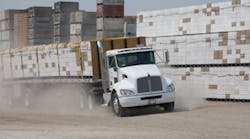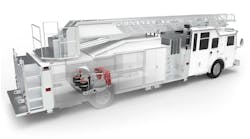Although driving behavior has the greatest impact on fuel consumption, there are some things that can be done to diesel engines to help with mileage improvements. One modification involves fine tuning an engine's electronics.
Today's medium duty diesel engines, like their heavy duty counterparts, are highly engineered power plants that incorporate electronics and computerization to optimize performance, fuel economy and emissions. Basically, the brain of the engine is the engine control module (ECM), also known as the electronic control unit (ECU). The central nervous system, if you will, is the sensors and harnessing located in the engine and throughout the rest of the vehicle that send information to the ECM.
The ECM interprets this information and, using fuel mapping technology, regulates the air/fuel mix by electronic fuel injection (EFI) to keep the engine operating at peak efficiency. Fuel mapping takes into consideration a number of conditions that are measured by sensors. These include vehicle speed, air intake, atmospheric conditions, throttle and boost.
To reprogram a diesel engine, to put it simply, a computer is connected to the ECM and changes are then made to its software. There are, however, limits to what adjustments can be done so as not to affect the engine's ability to comply with emission standards and to not "overstress" powertrain components.
"One of the key advantages that we brought to the market with the electronic engine controls is the ability to customize the programming to meet the operational needs of specific applications," says Dave Bryant, vocational sales manager-hybrids, Freightliner Trucks. "This includes things such as progressive shifting, road speed limiting, multiple PTO set speeds, ramp (acceleration) rate of PTO speeds and safety interlocks, to name a few.
"In many cases, a customer can also have the engine horsepower and torque rating revised by a software change only, or in combination with hardware changes," he continues. "In the case of engine rating changes, as opposed to operational parameter changes, any re-rate would need to be done with an EPA- and CARB (California Air Resources Board)-certified program to maintain compliance."
"EPA regulations prohibit the re-rating of an engine with an engine rating that is not certified for that engine platform," Mark Ehlers, Navistar's global special tools and diagnostics manager, adds. "The re-rating must also be compatible with all the impacted systems on the truck - fan, clutch, transmission, driveline, etc."
Many engine manufacturers have multiple horsepower and torque ratings to choose from for each of their respective engine families.
"Restrictions apply to ensure the engine has the correct match of components - pistons, cam, turbo, fuel system, etc. - to meet EPA, warranty and reliability guidelines," says Brian Coe, engineering technical steward, Caterpillar Truck Engines. "Additionally, you need to ensure that the rest of the drivetrain is matched to the new engine rating."
All engine builders advise checking with the engine and drivetrain manufacturer before making any changes.
"Cooling and exhaust system performance is critical with today's engines," Coe notes, "so don't forget to get approval from the vehicle OEM as well to make certain these and other chassis components are matched for the new engine rating."
In the case of Mack Trucks, by way of example, "any and all horsepower changes must be approved by Mack Trucks, and if approved, recorded to reflect the new horsepower data files, says David McKenna, the manufacturer's director of powertrain sales and marketing. "When a horsepower change request is received, we first make sure that the rest of the powertrain and cooling system can handle the new data file.
"This is one of the reasons that I always counsel buyers of lower horsepower engines to specify clutches, transmissions and cooling systems that will allow maximum horsepower upgrades for the resale market."
PROGRAMMABLE PARAMETERS
As for any type of engine reprogramming via the engine ECU, "very, very little is allowed and even then under strictly controlled circumstances," McKenna says. However, there are a great many customer programmable features in the vehicle ECU that are easily enabled/disabled or reprogrammed.
There are dozens of programmable engine parameters can be set using software approved by the engine manufacturer to help maximize efficiency, adds Mark Thomas, director electrical and electronic engineering, Daimler Trucks North America (DTNA). These include road speed governing, maximum vehicle speed, idle shut-down, gear-down protection and cruise control settings and limits.
The primary function of programmable parameters is to enable the vehicle to be customized to more closely meet the needs of the customer, Freightliner Trucks' Bryant says. For instance, a customer could have ordered a truck for a utility bucket application but then decided to upfit it with a digger/derrick. The PTO set speeds and demands are different for these applications and a certified dealer would be able to make these modifications.
"Customers are always looking for ways in which to improve performance and lower operating costs, observes McKenna of Mack Trucks. Engine manufacturers "offer the ability for this to be electronically accomplished to fine tune the truck to a specific application."
Reprogramming does not affect the engine's warranty provided it is done following the manufacturer's published protocols and policies, Navistar's Ehlers says. Warranty is also unaffected if reprogramming the engine parameters is done by a certified technician using software approved by the engine manufacturer and the appropriate tools.
"Most of the major fleets, both highway and vocational, have the ability to reprogram a predetermined level of features that do not effect either warranty or emission compliance," says McKenna.
When changing an engine rating, it has to be is approved by the engine manufacturer for the engine platform and components for the warranty to be unaffected, adds Caterpillar's Coe.
Engine rating changes are more commonly done by the engine manufacturer, Bryant says, and typically have a cost requirement which ensures the warranty is updated for the new rating.
SUBSTITUE PARTS
Replacing the ECM with a new or remanufactured unit is not an alternative method for improving engine performance. "There would be no difference whatsoever," explains Mack Trucks' McKenna. "It is the programming data within the ECU that will affect performance."
"Think of the ECU as the data bank - meaning that all pertinent information and control algorithms are stored here. A corrupted file can cause problems such as ghost codes - fault codes that are read but did not exist. Tampering is a common cause of this."
Engines are developed with software and fuel map calibration relative to an engine and how it will be used, and for emissions certification, says DTNA's Thomas. If ECUs have to be replaced, it should be with an OEM unit only. ECUs should not be tampered with by "unauthorized" people.
"OEM engineers spend thousands of hours validating engine calibrations in a wide range of operating conditions to ensure long-term performance, durability and emission compliance," adds Bryant of Freightliner Trucks. "Replacing the ECM with a non-OEM part would not be a recommended method to improve performance of the engine and most likely would void both the warranty and emission certification of the engine."
AFTERMARKET DEVICES
There are a number of aftermarket products and add-ons for reprogramming the engine management system to improve diesel engine performance and lower fuel costs. The engine manufacturers stress that before using such devices, vehicle owners should make certain that these devices do not interfere with the emissions compliance and performance of their engines.
"Engine manufacturers spend hundreds of millions of dollars to ensure the products they offer meet all of the federally mandated emissions requirements and provide the best possible performance," says Coe of Caterpillar. "In most instances," McKenna adds, "something that might improve performance in one area generally will compromise performance or legal compliance in another."
OEMs work with a number of electronic diagnostic tool manufactures to develop products that support varying levels of diagnostic and parameter programming, Bryant says. These tools should not be used to change engine calibrations related to emission compliance.
For example, he says that changes to fuel injection rates or timing that have not been certified to meet EPA and CARB compliance would not be approved by the engine manufacturer. However, adjusting the progressive shift rate or top speed to meet the needs of a specific fleet would be fine.
"Engine manufacturers generally do not condone tuning products," acknowledges Mike Litsch with DiabloSport, a company that designs and manufactures gasoline and diesel tuning systems. "They are often of the belief that they cause damage to the engine. Unfortunately, there are many products available, some better than others, and a few poor products have left a bad taste in the mouth of many of the manufacturers."
DiabloSport's diesel performance tuning products "can actually make the trucks run much better than OEM with no change in engine emissions," he says. The electronic products increase power and fuel mileage through optimizing fuel burn and boost output. The products function by communicating with the factory PCM (powertrain control) module through the OBDII communications port.
"We do quite a bit of work to get to a point where we can read and write the PCM, then we edit the files, test the tunes and develop a product safe for the retailer and ready to use," says Litsch.
Bully Dog Technologies is another vehicle performance company with products for diesel engines. Its Bully Dog Big Rig Power Pup programmers/tuners "give 6 to 12 percent mileage gains backed by a money back guarantee," says Greg Cox, national industrial sales manager, and notes that fuel economy savings have been documented by SAE J1321 Joint TMC/SAE Fuel Consumption Test Procedure Type II and field testing.
The devices download "safe and simple" engine software upgrades and reprogram the ECM with engine tuning modifica¬tions, he explains. These tunes are designed to improve the engine's efficiency, resulting in improved fuel economy and increased horsepower and torque.
Bully Dog engineers have worked to ensure that the programs do not exceed safety parameters, says Cox "We suggest using caution if you have already tuned the truck to the highest horsepower level or have the highest OEM horsepower tune for your configuration. Transmissions, clutches and drivelines already set to their highest horsepower level should not be exceeded."
As for whether diesel tuning systems affect the engine's warranty, DiabloSport's Litsch says: "Before we flash any vehicle, we read the stock tune out of the PCM, saving it so it can be restored back to the original setting at any time. While there is no trace of the tune actually having been there, it is always a good idea to restore the stock tune to the vehicle before going for any type of warranty repairs."
Bully Dog Technologies' product literature states: "The Bully Dog programs that are loaded onto the engines do not interfere with the current OEM tools. Unless you tell them that the program is loaded onto the tractor they will not know that it is there."
In January, Bully Dog joined the EPA's SmartWay Community program, which is under the umbrella of The SmartWay Transportation Partnership. It is a voluntary affiliation between various freight industry sectors and the EPA that establishes incentives for fuel efficiency improvements and greenhouse gas emissions reductions.
ENGINE FLEXIBILITY
With the sophistication of engine electronics and service tools, the day of the "diesel tuner" (a mechanic that can "tweak" an engine) is long gone, the engine builders say. "With earlier versions of engine data files, they were very simple and could easily be 'adjusted' to develop more power and speed," says Mack Trucks' McKenna. "Today the data files are huge and equally complex and are very difficult to modify, tweak, adjust or call it what it is - tampering."
"There is tremendous flexibility to modify the parameters on today's electronic engines to meet application needs," Bryant of Freightliner Trucks adds. "However, tweaking an engine for higher horsepower or torque apart from using an OEM-certified calibration is not recommended."
More horsepower and torque does not necessarily mean more fuel efficiency," says Caterpillar's Coe. "There may be no gains seen in tank mileage if the operator chooses to use all of the extra horsepower and torque you have just given him or her.
"The whole vehicle and the operational characteristics over the vehicle's normal route need to be studied before making changes. Make no mistake, the driver has the final say when it comes to fuel efficiency. Do not underestimate the value of driver training."




